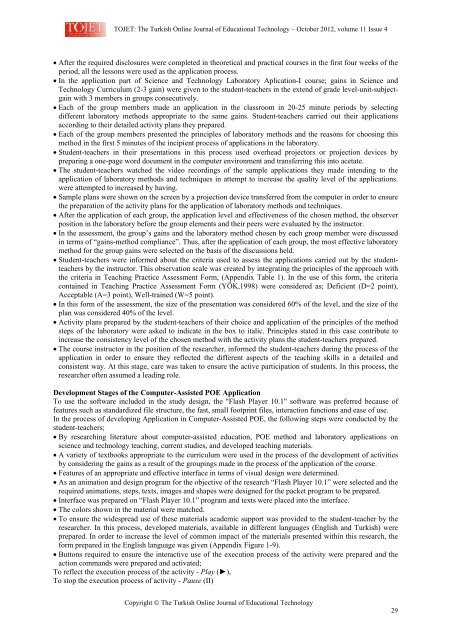october 2012 - TOJET the Turkish online journal of educational ...
october 2012 - TOJET the Turkish online journal of educational ...
october 2012 - TOJET the Turkish online journal of educational ...
Create successful ePaper yourself
Turn your PDF publications into a flip-book with our unique Google optimized e-Paper software.
<strong>TOJET</strong>: The <strong>Turkish</strong> Online Journal <strong>of</strong> Educational Technology – October <strong>2012</strong>, volume 11 Issue 4<br />
• After <strong>the</strong> required disclosures were completed in <strong>the</strong>oretical and practical courses in <strong>the</strong> first four weeks <strong>of</strong> <strong>the</strong><br />
period, all <strong>the</strong> lessons were used as <strong>the</strong> application process.<br />
• In <strong>the</strong> application part <strong>of</strong> Science and Technology Laboratory Aplication-I course; gains in Science and<br />
Technology Curriculum (2-3 gain) were given to <strong>the</strong> student-teachers in <strong>the</strong> extend <strong>of</strong> grade level-unit-subjectgain<br />
with 3 members in groups consecutively.<br />
• Each <strong>of</strong> <strong>the</strong> group members made an application in <strong>the</strong> classroom in 20-25 minute periods by selecting<br />
different laboratory methods appropriate to <strong>the</strong> same gains. Student-teachers carried out <strong>the</strong>ir applications<br />
according to <strong>the</strong>ir detailed activity plans <strong>the</strong>y prepared.<br />
• Each <strong>of</strong> <strong>the</strong> group members presented <strong>the</strong> principles <strong>of</strong> laboratory methods and <strong>the</strong> reasons for choosing this<br />
method in <strong>the</strong> first 5 minutes <strong>of</strong> <strong>the</strong> incipient process <strong>of</strong> applications in <strong>the</strong> laboratory.<br />
• Student-teachers in <strong>the</strong>ir presentations in this process used overhead projectors or projection devices by<br />
preparing a one-page word document in <strong>the</strong> computer environment and transferring this into acetate.<br />
• The student-teachers watched <strong>the</strong> video recordings <strong>of</strong> <strong>the</strong> sample applications <strong>the</strong>y made intending to <strong>the</strong><br />
application <strong>of</strong> laboratory methods and techniques in attempt to increase <strong>the</strong> quality level <strong>of</strong> <strong>the</strong> applications.<br />
were attempted to increased by having.<br />
• Sample plans were shown on <strong>the</strong> screen by a projection device transferred from <strong>the</strong> computer in order to ensure<br />
<strong>the</strong> preparation <strong>of</strong> <strong>the</strong> activity plans for <strong>the</strong> application <strong>of</strong> laboratory methods and techniques.<br />
• After <strong>the</strong> application <strong>of</strong> each group, <strong>the</strong> application level and effectiveness <strong>of</strong> <strong>the</strong> chosen method, <strong>the</strong> observer<br />
position in <strong>the</strong> laboratory before <strong>the</strong> group elements and <strong>the</strong>ir peers were evaluated by <strong>the</strong> instructor.<br />
• In <strong>the</strong> assessment, <strong>the</strong> group’s gains and <strong>the</strong> laboratory method chosen by each group member were discussed<br />
in terms <strong>of</strong> “gains-method compliance”. Thus, after <strong>the</strong> application <strong>of</strong> each group, <strong>the</strong> most effective laboratory<br />
method for <strong>the</strong> group gains were selected on <strong>the</strong> basis <strong>of</strong> <strong>the</strong> discussions held.<br />
• Student-teachers were informed about <strong>the</strong> criteria used to assess <strong>the</strong> applications carried out by <strong>the</strong> studentteachers<br />
by <strong>the</strong> instructor. This observation scale was created by integrating <strong>the</strong> principles <strong>of</strong> <strong>the</strong> approach with<br />
<strong>the</strong> criteria in Teaching Practice Assessment Form, (Appendix Table 1). In <strong>the</strong> use <strong>of</strong> this form, <strong>the</strong> criteria<br />
contained in Teaching Practice Assessment Form (YÖK,1998) were considered as; Deficient (D=2 point),<br />
Acceptable (A=3 point), Well-trained (W=5 point).<br />
• In this form <strong>of</strong> <strong>the</strong> assessment, <strong>the</strong> size <strong>of</strong> <strong>the</strong> presentation was considered 60% <strong>of</strong> <strong>the</strong> level, and <strong>the</strong> size <strong>of</strong> <strong>the</strong><br />
plan was considered 40% <strong>of</strong> <strong>the</strong> level.<br />
• Activity plans prepared by <strong>the</strong> student-teachers <strong>of</strong> <strong>the</strong>ir choice and application <strong>of</strong> <strong>the</strong> principles <strong>of</strong> <strong>the</strong> method<br />
steps <strong>of</strong> <strong>the</strong> laboratory were asked to indicate in <strong>the</strong> box to italic. Principles stated in this case contribute to<br />
increase <strong>the</strong> consistency level <strong>of</strong> <strong>the</strong> chosen method with <strong>the</strong> activity plans <strong>the</strong> student-teachers prepared.<br />
• The course instructor in <strong>the</strong> position <strong>of</strong> <strong>the</strong> researcher, informed <strong>the</strong> student-teachers during <strong>the</strong> process <strong>of</strong> <strong>the</strong><br />
application in order to ensure <strong>the</strong>y reflected <strong>the</strong> different aspects <strong>of</strong> <strong>the</strong> teaching skills in a detailed and<br />
consistent way. At this stage, care was taken to ensure <strong>the</strong> active participation <strong>of</strong> students. In this process, <strong>the</strong><br />
researcher <strong>of</strong>ten assumed a leading role.<br />
Development Stages <strong>of</strong> <strong>the</strong> Computer-Assisted POE Application<br />
To use <strong>the</strong> s<strong>of</strong>tware included in <strong>the</strong> study design, <strong>the</strong> "Flash Player 10.1" s<strong>of</strong>tware was preferred because <strong>of</strong><br />
features such as standardized file structure, <strong>the</strong> fast, small footprint files, interaction functions and ease <strong>of</strong> use.<br />
In <strong>the</strong> process <strong>of</strong> developing Application in Computer-Assisted POE, <strong>the</strong> following steps were conducted by <strong>the</strong><br />
student-teachers;<br />
• By researching literature about computer-assisted education, POE method and laboratory applications on<br />
science and technology teaching, current studies, and developed teaching materials.<br />
• A variety <strong>of</strong> textbooks appropriate to <strong>the</strong> curriculum were used in <strong>the</strong> process <strong>of</strong> <strong>the</strong> development <strong>of</strong> activities<br />
by considering <strong>the</strong> gains as a result <strong>of</strong> <strong>the</strong> groupings made in <strong>the</strong> process <strong>of</strong> <strong>the</strong> application <strong>of</strong> <strong>the</strong> course.<br />
• Features <strong>of</strong> an appropriate and effective interface in terms <strong>of</strong> visual design were determined.<br />
• As an animation and design program for <strong>the</strong> objective <strong>of</strong> <strong>the</strong> research “Flash Player 10.1” were selected and <strong>the</strong><br />
required animations, steps, texts, images and shapes were designed for <strong>the</strong> packet program to be prepared.<br />
• Interface was prepared on “Flash Player 10.1” program and texts were placed into <strong>the</strong> interface.<br />
• The colors shown in <strong>the</strong> material were matched.<br />
• To ensure <strong>the</strong> widespread use <strong>of</strong> <strong>the</strong>se materials academic support was provided to <strong>the</strong> student-teacher by <strong>the</strong><br />
researcher. In this process, developed materials, available in different languages (English and <strong>Turkish</strong>) were<br />
prepared. In order to increase <strong>the</strong> level <strong>of</strong> common impact <strong>of</strong> <strong>the</strong> materials presented within this research, <strong>the</strong><br />
form prepared in <strong>the</strong> English language was given (Appendix Figure 1-9).<br />
• Buttons required to ensure <strong>the</strong> interactive use <strong>of</strong> <strong>the</strong> execution process <strong>of</strong> <strong>the</strong> activity were prepared and <strong>the</strong><br />
action commands were prepared and activated;<br />
To reflect <strong>the</strong> execution process <strong>of</strong> <strong>the</strong> activity - Play (►),<br />
To stop <strong>the</strong> execution process <strong>of</strong> activity - Pause (II)<br />
Copyright © The <strong>Turkish</strong> Online Journal <strong>of</strong> Educational Technology<br />
29
















